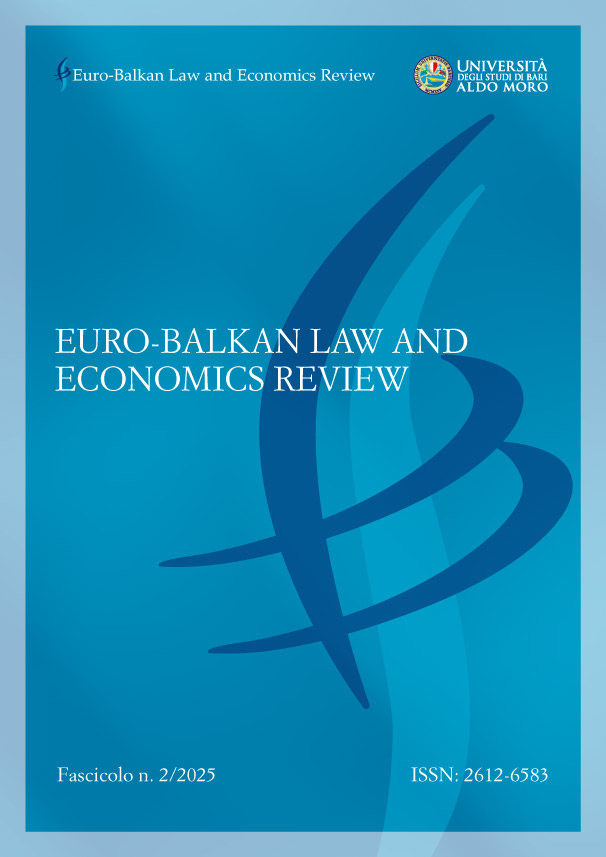Note sulle attività connesse e strumentali esercitate dalle banche tra diritto interno e dell’Unione Europea. Dai telefoni fissi agli smartphone
DOI:
https://doi.org/10.15162/2612-6583/2279Parole chiave:
Attività bancaria, Attività connesse e strumentali, Piattaforme digitali, Servizi di pagamento, Banking-as-a-service (BaaS), Banking-as-a-platform (BaaP), FinTech, Banking activity, Ancillary and Instrumental activities, Digital platforms, Payment servicesAbstract
L’articolo esamina l’estensione dell’operatività bancaria ai sensi dell’art. 10, comma 3, del Testo Unico Bancario (TUB), che autorizza le banche a svolgere attività strumentali e connesse. Tali categorie sono interpretate come relazionali e non alternative, riferibili non solo alle funzioni bancarie principali, ma anche alle ulteriori attività finanziarie autorizzate, escludendo tuttavia relazioni indirette o di secondo grado. Si ritiene che tali attività debbano possedere autonomia imprenditoriale e una destinazione al mercato, non potendosi ridurre a meri atti interni o operazioni prive di rilevanza esterna. Con riferimento alle attività strumentali, si confrontano due impostazioni: una restrittiva, che le assimila a funzioni ausiliarie interne, e una più ampia e preferibile, che ne ammette lo svolgimento anche a favore di terzi, entro limiti di non prevalenza, valorizzando l’efficienza concreta nell’impiego delle risorse. Quanto alle attività connesse, l’analisi si concentra sul criterio della relazione funzionale con l’organizzazione aziendale della banca, inclusa la rete fisica e digitale. Si argomenta che tali attività debbano essere valutate in base alla loro compatibilità con una gestione sana e prudente, assicurando che non alterino il profilo di rischio della banca né compromettano l’adeguatezza dei controlli interni. Si sostiene inoltre che i limiti previsti per le società strumentali – ossia le entità partecipate dalle banche – non debbano essere estesi alle attività connesse, favorendo una nozione di relazione funzionale orientata alla promozione dell’attività principale. A livello europeo, si evidenzia il silenzio del Regolamento sui requisiti patrimoniali (CRR) in merito alle attività “commerciali” esercitabili dalle banche. Sebbene le Opinion dell’Autorità Bancaria Europea (EBA) del 2014 e del 2020 sollecitino chiarimenti, esse si limitano a richiamare la nozione di impresa strumentale, rivelandosi inadeguate a sostenere l’evoluzione delle banche in chiave di piattaforma digitale. Di conseguenza, si propone che il legislatore europeo autorizzi espressamente le banche a gestire piattaforme proprie per la distribuzione di beni e servizi non bancari, sfruttando la leva della prestazione di servizi di pagamento (con riferimento ad esperienze estere). Tale evoluzione normativa consentirebbe alle banche di rispondere ai mutamenti della domanda digitale, partendo dalla prospettiva delle esigenze della clientela, superando la rigida centralità dell’attività bancaria tradizionale e rafforzando il rapporto diretto con i clienti.
This article examines the scope of banking operations under Article 10(3) of the Italian Consolidated Law on Banking (TUB), which authorizes banks to engage in ancillary and instrumental activities. These categories are interpreted as relational and non-mutually exclusive, encompassing not only core banking functions but also other authorized financial services, while excluding indirect or second-degree relationships. It is maintained that such activities must possess entrepreneurial autonomy and be directed toward the market, rather than consisting of mere internal acts or transactions. Regarding instrumental activities, a comparison is drawn between a restrictive approach - equating them with internal auxiliary functions - and a broader, preferable interpretation that allows their provision to third parties within non-prevalence limits, thereby enhancing resource efficiency in practice. With respect to ancillary activities, the analysis focuses on the criterion of functional linkage with the bank’s organizational structure, including both physical and digital infrastructures. It is argued that such activities must be assessed for their compatibility with sound and prudent management, ensuring they do not alter the bank’s risk profile or compromise the adequacy of internal controls. It is further contended that the limitations applicable to instrumental companies - i.e., entities in which banks may hold participations - should not be extended to ancillary activities. This supports a notion of functional linkage oriented toward the promotion of the bank’s core business. At the European level, attention is drawn to the silence of the Capital Requirements Regulation (CRR) regarding the “commercial” activities that banks may undertake. Although the European Banking Authority (EBA) Opinions (2014; 2020) call for clarification, they merely refer to the concept of instrumental undertakings, which appears insufficient to support the evolution of banks into digital platforms. Accordingly, it is proposed that EU legislators explicitly authorize banks to operate proprietary platforms for the distribution of non-banking goods and services, leveraging the provision of payment services (with reference to foreign experiences). Such a regulatory development would enable banks to respond to the changing dynamics of digital demand, starting from the perspective of customer needs e thus moving beyond the rigid centrality of traditional banking activities and reinforcing their direct relationship with customers.






